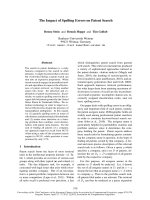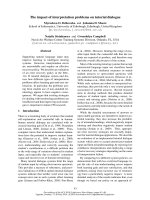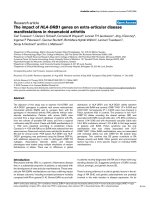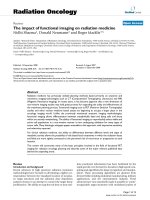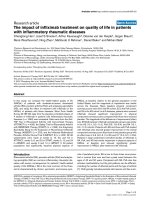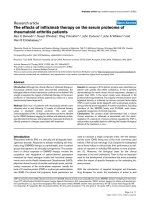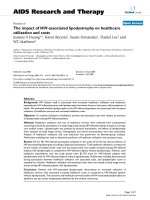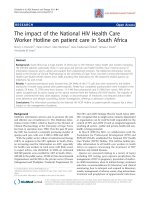Báo cáo y học: " The impact of mental illness on potentially preventable hospitalisations: a population-based cohort stu" ppt
Bạn đang xem bản rút gọn của tài liệu. Xem và tải ngay bản đầy đủ của tài liệu tại đây (1.2 MB, 11 trang )
RESEARCH ARTICLE Open Access
The impact of mental illness on potentially
preventable hospitalisations: a population-based
cohort study
Qun Mai
1*
,CD’Arcy J Holman
1
, Frank M Sanfilippo
1
and Jonathan D Emery
2
Abstract
Background: Emerging evidence indicates an association between mental illness and poor quality of physical
health care. To test this, we compared mental health clients (MHCs) with non-MHCs on potentially preventable
hospitalisations (PPHs) as an indicator of the quality of primary care received.
Methods: Population-based retrospective cohort stud y of 139,208 MHCs and 294,180 matched non-MHCs in
Western Australia from 1990 to 2006, using linked data from electoral roll registrations, mental health registry
(MHR) records, hospital inpatient discharges and deaths. We used the electoral roll data as the sampling frame for
both cohorts to enhance internal validity of the study, and the MHR to separate MHCs from non-MHCs. Rates of
PPHs (overall and by PPH category and medical condition) were compared between MHCs, category of mental
disorders and non-MHCs. Multivariate negative binomial regression analyses adjusted for socio-demographic
factors, case mix and the year at the start of follow up due to dynamic nature of study cohorts.
Results: PPHs accounted for more than 10% of all hospital admissions in MHCs, with diabetes and its
complications, adverse drug events (ADEs), chronic obstructive pulmonary disease (CO PD), convulsions and
epilepsy, and congestive heart failure being the most common causes. Compared with non-MHCs, MHCs with any
mental disorders were more likely to experience a PPH than non-MHCs (overall adjusted rate ratio (ARR) 2.06, 95%
confidence interval (CI) 2.03-2.09). ARRs of PPHs were highest for convulsions and epilepsy, nutritional deficiencies,
COPD and ADEs. The ARR of a PPH was highest in MHCs with alcohol/drug disorders, affective psychoses, other
psychoses and schizophrenia.
Conclusions: MHCs have a significantly higher rate of PPHs than non-MHCs. Improving primary and secondary
prevention is warranted in MHCs, especially at the primary care level, despite there may be different thresholds for
admission in people with established physical disease that is influenced by whether or not they have comorbid
mental illness.
Background
Health care disparities in vulnerable populations are a
public health and ethical challenge [1]. Previous studies
have been predominately focused on raci al/ethnic [2],
socioeconomic [3] or geographic related disparities [4].
Mental illness related disparities have been g iven less
attention [5].
About 1 in 5 Australian adults has a clinically diagno-
sable mental illness [6]. This vulnerable group not only
suffer from debilitating disability and a high risk of sui-
cide [7], but also high risks of morbidity and mortality
from physical illness [8]. The 2000 Duty to Care study
found that Western Australian (WA) mental health cli-
ents (MHCs), generally with moderate to severe mental
illness, had an overall 2.5 times higher mortality rate
than the general population, mostly due to preventable
physical diseases [8]. Apart from g eneti c, lifestyle, social
and environmental factors, disparities in access to, and
the quality of, physical health care may also contribute
to this [9]. Access to care is a prerequisite for quality of
care, whilst primary care is a foundation for population
health, especially for vulnerable groups [10]. Our
* Correspondence:
1
School of Population Health, The University of Western Australia, 35 Stirling
Highway, Crawley, WA, 6009, Australia
Full list of author information is available at the end of the article
Mai et al. BMC Psychiatry 2011, 11:163
/>© 2011 Mai et al; licensee BioMed Central Ltd. This is an Open Access article distributed under the terms of the Cre ative Commons
Attribution License ( which permits unrestricted use, distribution, and reproduction in
any medium, provided the original work is properly cited.
previous study found that MHCs had substantially more
general practitioner (GP) visits than non-MHCs [11].
This suggests that, in Australia, with its universal health
insurance cover provided by Medicare, it appears unli-
kely that limited access to primary care explains poor
physical health outcomes in MHCs. We have therefore
turned our focus on whether disparities exist in the
quality of primary care using potentially preventable
hospitalisations (PPHs) as an indicator [12]. This is
because the data we have cannot measure quality of pri-
mary care directly but indicators of it. These indicators
of quality of primary care are useful screening tools for
potential problems in preventive and primary care, and
that determining whether there is a quality problem
requires more in-depth analysis.
PPH medical conditions, also known as avoidable hos-
pital isation conditions or ambu latory care sensitive con-
ditions, are those for which good primary and
preventive care are thought that could potentially pre-
vent the need for hospitalisation, and are thus consid-
ered as indicators for access to, and the quality of,
primary care [12]. Early studies categorised PPH medical
conditions into: vaccine-preventable , chronic and acute
[13]. Adverse events are now also included, adding a
safety measure of quality [13].
Previous studies have examined: (i) mental illness-
related disparities in the qua lity of physical health care
across several physical conditions, such as coronary
heart disease [14] and diabetes mellitus [15]; and (ii)
racial/ethnic, socioeconomic and geographic-related dis-
parities in PPHs [16-18]. However, to our knowledg e,
no study has specifically examined me ntal illness-related
disparities in PPHs. To address this, we linked multiple
population-based datasets to answer four specific ques-
tions: (i) do MHCs have more PPHs than non-MHCs;
(ii) which PPH category/medical condition has the high-
est relative risk; (iii) do the associations vary by category
of mental disorders; and (iv) what would be the poten-
tial savings in hospital admiss ions if MHCs had received
the ‘same’ quality of primary care as non-MHCs.
Methods
We conducted a population-based retrospective cohort
studyfortheperiod1January1990to30June2006in
WA.
Data sources
We linked four de-identified routinely collected datasets
from the WA Data Linkage System [19,20] (see Addi-
tional File 1, Table S1): (i) mental health registry (MHR,
8% of th e general population), (ii) electo ral roll registra-
tions (86% of the general population aged ≥ 18 years),
(iii) hospital inpatient discharges, and (iv) deat h
registrations.
The MHR co ntained mental hea lth inpatient data
from all psychiatric institutions, public and private gen-
eral hospitals, and outpatient data from public mental
health clinics, community mental health services and
psychiatric residential units. Data from private psychia-
trists and GPs treating mental disorders were collected
and administered by the C ommonwealth Department of
Health and thus not covered in the MHR.
Study cohorts
To enhance the internal validity of the study, we used
the electoral roll as the sampling frame for both MHCs
and non-MHCs to ensure that the baseline populations
- MHCs and non-MHCs - came ultimately from the
same source (Figure 1). The WA state-wide electoral
roll data is a single dataset that contains the complete
set of 1988 WA state electoral roll registrations and all
quarterly updates of changes o f enrolment status since
then, e.g. new enrolments as well as removals from the
roll due to unsound mind, moved out of state or death.
The data set contains information on encrypted ID, date
of transaction, reason for the transaction, sex, date of
birth and place of residence. MHCs were defined as
people on the electoral roll, who were also on the MHR
(about 80% of MHR) and still alive from 1 January 1990
onwards. Non-MHCs were a random sample of people
who were on the electoral roll, but never recorded in
the MHR. They were matched 2:1 with MHCs by 5-year
age group, sex and current electoral roll registration at
study entry. Age is calculated from date of birth and
study entry date. For MHCs, the study entry date was 1
January 1990 for patients recorded in the MHR before 1
January 1990, or the first date of registration on the
MHR for those recorded later. For non-MHCs, it was
the same as that of their matched MHCs. The start of
follow-up (T
0
) was the entry date for both cohorts.
Variables and measurements
Outcome variables
TheoutcomemeasurewastherateofPPHsduringthe
follow-up period from 1 Jan 1990 to 31 Dec 2006.
There were four categories of PPH medical conditions
investigated (see Additional File 1, Table S2): vaccine-
preventable, chronic, acute and adverse drug events
(ADEs). The first three ca tegories were identified using
the Australian Institute of Health and Welfare definition
[21], with diabetes-related renal dialysis being counted
only once for each person. This was because there were
a large number of diabetes-related renal dialysis admis-
sions, and for the purpose of thisstudyweconsidered
these as one episode o f care per person and counted as
one h ospital discharge with a length of stay of one day.
We substi tuted adverse events with ADEs as the major-
ity of advents events were ADEs, defined as any adverse
Mai et al. BMC Psychiatry 2011, 11:163
/>Page 2 of 11
effect of drugs, medicines or biological substances in
therapeutic use (ICD-9-CM, E930-E949 or ICD-10-AM,
Y40-Y59). Follow-up time was censored at 30 June 2006
or an earlier date of death.
Exposure variables
We ascertained the principal mental health diagnosis for
each MHC using a previously published method [11,22],
which assigned patients to their most signi ficant mental
health diagnosis on an hierarchy of severi ty (see Addi-
tional File 1, Table S1). People wit h dementia (n =
15,764) were excluded due to their high use of residen-
tial care, but their matched non-MHCs were retained to
maintain the high precision possible in a study of this
size. The remaining records were th en grouped into one
of ten mutually exclusive categories of mental disorders
(see Additional File 1, Table S1).
Potential confounders
Scores for social disadvantage and reside ntial remote-
ness were de rived from the Index of Relativ e Socio-Eco-
nomic Disadvantage (IRSD) [23] and the Accessibility/
Remoteness Index of Australia (ARIA) [24] based on
place of residence at the Australian Census date. Social
disadvantage scores were grouped into five levels (the
lowest10%ofIRSDscoresoftheWAgeneralpopula-
tion, 10% to < 25%, 25% to < 50%, 50% to < 75% and ≥
75%) and remoteness scores were grouped into metro-
politan, rural and remote. The category of the lowest
10% IRSD was created because a high proportion of
MHCs fell into this group. Age, level of s ocial
disadvantage, level of residential remoteness and year at
the start of follow up were measured at T
0
.Physical
comorbidities were measured by the Charlson Index
[25] based on inpatient data with a five-year look-back
period from T
0
.
Statistical analysis
We compared patient characteristics and crude numbers
of hospital discharges, bed days and average length of
stay during the entire follow-up period between MHCs
and non-MHCs using bivari ate analyses (chi-squared or
unpaired tests for categorical variables, two-tailed t- or
Mann-Whitney tests for continuous variables).
We then compared rates of PPHs between the two
cohorts using unadjusted and adjusted negative binomial
regression. Adjusted analyses controlled f or potential
patient-level confounders: 5-year age group, sex, Indi-
genous status, level of social disadvantage, level of resi-
dential remoteness, physical comorbidities (Charlson
Index as a continuous variable) and year at T
0
.We
repeated the above analyses for each PPH ca tegory and
condition. Because MHCs represented a heterogeneous
group, we repeated the above analyses, comparing
MHCs in each category of mental disorder with non-
MHCs.
We calculated the etiological fraction of mental illness
attributable to disparities in PPHs as (Rate Ratio-1)/Rate
Ratio and estimated the potential savings in hospital
admissions and bed days if MHCs had experienced the
Western Australian Data Linkage System
Including ER (from 1988), MHR (from 1966)
,
hospital inpatient
(from 1990), death data
(from 1990)
Linking cohort data with hospital inpatient and death data (from 1990)
Linking ER and MHR data
MHCs (ER and MHR from 1988)/ Non-
MHCs (a random sample of
ER only from 1988)*
MHCs
(n=139,208)
Non-
MHCs
(n=294,180)
Excluding died before 1
Jan
1990 and dementia
Excluding MHR only
and the rest of ER only
Figure 1 Selection of study cohorts. Abbreviations: ER = electoral roll registr ations, MHCs = mental health c lients, MHR = mental health
registry. * Non-MHCs matched 2:1 with MHCs by 5-year age group, sex and being a current elector at study entry. The final ratio of non-MHC to
MHC was 2.11:1 after excluding MHCs with dementia.
Mai et al. BMC Psychiatry 2011, 11:163
/>Page 3 of 11
same PPH outcomes as non-MHCs, determined by mul-
tiplying hospital discharges by the etiological fraction.
Missing values for each variable were treated as a
separate exposure category so that all subjects we re
included in the m ultivariate analyses. Stata version 10.0
for Windows (StataCorp, College Station, Tex, USA)
was used for all analyses.
The study was approved by the Human Research
Ethics Committees of The University of Western Aus-
tralia, and health departments of the Australian and
WA governments.
Results
Patient characteristics
The study cohorts comprised 139,208 MHCs and
294,180 non-MHCs. Characteristics of MHCs and non-
MHCs at T
0
are shown in Table 1. Relative to non-
MHCs,MHCsweremorelikelytobeIndigenous,
socially disadvantaged, living in rural or remote WA and
have more physical comorbidities (all p-values < 0.001).
The distribution of mental disorders among MHCs is
also shown in Table 1, with affective psychoses and neu-
rotic disorders being the most common.
Descriptive analyses
Numbers of hospital discharges, bed days and average
length of stay of total hospital admissions and PPHs
(total and by PPH category and medical condition) f or
both cohorts during entire follow-up period are shown
in Table 2. PPHs accounted for more than 10% of all
hospital discharges in both groups (Table 2). The most
common PPH medical conditions in MHCs were dia-
betes and its complications, ADEs, chronic obstructive
pulmonary disease (COPD), convulsions and epilepsy,
and congestive heart failure. ADEs, diabetes and its
complications, COPD and congestive heart failure had
the highest numbers of total bed days. PPH medical
conditions with the longest a verage length of stay were
Table 1 Characteristics of mental health clients (MHCs) and non-MHCs at the start of follow up
Characteristic* MHCs
(n = 139,208)
Non-MHC
(n = 294,180)
Age, years, mean (SD) 43.7 (18.6) 45.1 (19.7)
Sex, % male 40.3% 40.4%
Indigenous status, %
Indigenous (excluding missing) 5.7% (5.7%) 2.1% (2.3%)
Non-Indigenous (excluding missing) 93.9% (94.3%) 87.9% (97.7%)
Missing 0.4% 10.0%
Level of social disadvantage
Most disadvantaged (the lowest 10% of IRSD scores**) 14.8% 10.9%
More disadvantaged (10% to < 25%) 18.7% 15.8%
Little disadvantaged (25% to < 50%) 25.4% 23.6%
Less disadvantaged (50% to < 75%) 18.5% 20.1%
Least disadvantaged (75%+) 22.6% 29.6%
Residential remoteness
Metropolitan WA 68.6% 73.0%
Rural WA 22.7% 20.6%
Remote WA 8.7% 6.4%
Physical comorbidity (Charlson) score, mean (SD) 1.28 (2.34) 1.04 (2.24)
Category of mental disorders (%)
Alcohol/drug disorders 8.0% -
Schizophrenia 4.2% -
Affective psychoses 17.1% -
Other psychoses 6.7% -
Neurotic disorders 16.2% -
Personality disorders 2.5% -
Adjustment disorders 7.3% -
Depressive disorders 4.4% -
Other mental disorders 8.0% -
In MHR but had no mental health diagnosis, including suicide attempts 25.5% -
Abbreviations: MHCs = mental health clients, SD = stand ard deviation, WA = Western Australia, MHR = mental health registry.
*P-values < 0.001 for all comparisons between MHCs and non-MHCs, except for sex (p = 0.52).
**The lowest 10% of IRSD scores of the Western Australian general population.
Mai et al. BMC Psychiatry 2011, 11:163
/>Page 4 of 11
gangrene, nutritional deficiencies, ADEs, and influenza
and pneumonia.
Rate of PPHs
Compared with non-MHCs, MHCs had significantly
higher rates of PPHs from both univariate and multi-
variate analyses (unadjusted rate ratio (RR) 2.12, 95% CI
2.07-2.16; adjusted RR (ARR) 2.06, 2.03-2.09) (Figure 2).
By PPH category and condition
When we stratified analyses by PPH category and specific
condition, ARRs were greater than one for all PPH cate-
gories and medical conditions, except appendicitis with
generalised peritonitis (0.88, 0.75-1.03) (Table 3). By PPH
category, ARRs were highest for A DEs (2.66, 2.58-2.74),
followed by va ccine-preventable (2.10, 1.97-2.23), acute
(2.08, 2.04-2.13) and chronic conditions (1.82, 1.78-1.87).
By PPH medical conditions, ARRs were highest for con-
vulsions and epilepsy (6.45, 5.89-7.07), nutritional defi-
ciencies (4.81, 1.43-16.21), COPD (2.64, 2.47-2.83) and
asthma (2.47, 2.30-2.66); although nutritional deficiencies
had the lowest absolute numbers (21 in MHCs and 10 in
non-MHCs ). Other findings included that ARR increased
with the year at the start of follow up (ARR 1.02, 95%
1.01-1.02, for each increment in year), age, social disad-
vantage, residential remoteness and level of physical
comorbiditi es. It was al so greater in females than males
and Indigenous people than non-Indigenous people.
Rate ratios by category of mental disorders
ARRs of PPHs in MHCs with any mental disorders were
all greater than one (Figure 3), with the highest for
Table 2 Hospital discharges, bed days and average length of stay for potentially preventable hospitalisations by study
cohort, PPH category and condition, 1 January 1990 to 30 June 2006
PPH category/condition Discharges in
MHCs
(n = 139,208)
Discharges in
Non-MHC
(n = 294,180)
Bed-days in
MHCs
(n = 139,208)
Bed-days in
Non-MHC
(n = 294,180)
ALOS (days) in
MHCs
(n = 139,208)
ALOS (days) in
Non-MHC
(n = 294,180)
Vaccine-preventable* 3,055 3,205 38,465 35,819 12.6 11.2
Influenza and pneumonia 2,786 2,879 35,847 33,154 12.9 11.5
Other vaccine-preventable conditions 270 328 2,686 2,682 9.9 8.2
Chronic* 48,350 62,644 309,642 403,664 6.4 6.4
Asthma 6,483 4,337 31,435 21,496 4.8 5.0
Congestive heart failure 6,844 13,138 58,954 121,571 8.6 9.3
Diabetes complications† 17,823 23,837 115,418 149,139 6.5 6.3
COPD 9,703 10,466 87,385 93,766 9.0 9.0
Angina 6,292 8,680 19,157 28,029 3.0 3.2
Iron deficiency anaemia 2,466 4,469 5,936 10,503 2.4 2.4
Hypertension 1,497 1,598 7,731 7,214 5.2 4.5
Nutritional deficiencies 21 10 363 289 17.3 28.9
Rheumatic heart disease 304 521 2,519 4,262 8.3 8.2
Acute* 33,329 30,720 148,426 156,055 4.5 5.1
Dehydration and gastroenteritis 5,578 6,404 17,696 20,861 3.2 3.3
Pyelonephritis 6,005 6,408 35,220 40,422 5.9 6.3
Perforated/bleeding ulcer 1,090 1,737 8,000 13,040 7.3 7.5
Cellulitis 4,334 4,574 23,089 28,398 5.3 6.2
Pelvic inflammatory disease 1,622 1,366 4,922 3,908 3.0 2.9
Ear, nose and throat infections 1,989 1,810 6,460 6,038 3.2 3.3
Dental conditions 3,724 5,147 5,812 6,658 1.6 1.3
Appendicitis with generalised peritonitis 244 497 2,096 3,138 8.6 6.3
Convulsions and epilepsy 8,036 1,830 31,376 9,259 3.9 5.1
Gangrene 726 980 14,050 24,460 19.4 25.0
Adverse drug events 16,002 15,683 211,495 174,786 13.2 11.1
Total PPHs* 96,862 107,821 665,517 720,975 6.9 6.7
Total hospital admissions† 912,175 1,013,403 5,579,134 4,413,672 6.1 4.4
Abbreviations: MHCs = mental health clients, PPH = potentially preventable hospitalisations, COPD = chronic obstructive pulmonary disease, ALOS = average
length of stay (days).
*There were overlaps in definitions for PPHs, therefore the total numbers for each PPH categories and total PPHs were not the same as the sum of individual
PPHs. †During follow-up period, there were a total of 183,846 hospital separations for renal dialysis among 919 persons. For the purpose of this study, all renal
dialysis admissions were counted as one hospital episode for each person with length of stay of one day. The same definition was also applied for diabetes-
related renal dialysis.
Mai et al. BMC Psychiatry 2011, 11:163
/>Page 5 of 11
alcohol and drug disorders (3.00, 2.88-3.13), affective
disorders (2.58, 2.50-2.66), other psychoses (2.36, 2.26-
2.47) and schizophrenia (2.25, 2.12-2.39). The leading
causes of excess PPHs for these four categories of men-
tal disorders are shown in Table 4.
Potential savings
Greenland and Robins have described three different
types of attributable fraction in the exposed [26]. In this
study, the incidence density fraction of PPHs in MHCs
attributable to their mental illness was 51.4%, based on
an ARR of 2.06 (Table 3). Strictly, the incidence density
fraction will only equal the true etiologic fraction when
exposure acts independently of background causes [27],
but otherwise the approximation is often conservative
[28]. Thus, a rough estimate of the potent ial savings is
that if the elevated rate of PPHs in the mentally ill
observed in Western Australia was caused by
Figure 2 Unadjusted (univariate analysis) and adjusted (multivariate analysis) rate ratios of potentially preventable hospital isations
(PPHs) from negative binomial regression analysis, stratified by PPH category and medical condition, 1 January 1990 to 30 June 2006.
Abbreviations: PPHs = potentially preventable hospitalisations, URR = unadjusted rate ratio, ARR = adjusted rate ratio, MHCs = mental health
clients, COPD = chronic obstructive pulmonary disease. Notes: URRs and ARRs for nutritional deficiencies and convulsions and epilepsy were
eliminated from the figure because of the larger numbers, which can be found from Table 2. Multivariate regression model adjusted for 5-year
age group, sex, Indigenous status, level of social disadvantage, level of residential remoteness, physical comorbidities and year at the start of
follow up. The reference group was non-MHCs.
Mai et al. BMC Psychiatry 2011, 11:163
/>Page 6 of 11
suboptimal health care, then had that inequality in care
been redressed, it could have translated into 49,787 (i.e.,
96,862 × 51.4%) fewer hospital admissions at the times
that they occurred during follow-up.
Discussion
We used a populat ion-based approach to examine men-
tal illness related disparities in PPHs. The results
showed that: (i) diabetes and its complications, ADEs,
COPD, convulsions and epilepsy, and congestive heart
failure were the most common PPHs in MHCs; (i i) on
average, MHCs were about twice as likely as non-MHCs
to experience a PPH, with the largest differ ences occur-
ring in PPHs for convulsions and epilepsy, nutritional
deficiencies, ADEs, COPD and asthma; (iii) although
ARRs were greater than 1 in MHCs with any mental
disorders, it was higher in those with relatively mo re
debilitating mental disorders such as al cohol and drug
disorders, affe ctive psychoses, other psychoses and schi-
zophrenia; (iv) the disparities seem to have been increas-
ing over the years; and (v) potentially half of all acute
hospital admissions for PPHs could be avoided if MHCs
had received preventive and primary care that achieved
the same PPH outcomes as observed in non-MHCs.
The strengths of our study were: (i) use of validated
population-based linked data with over 400,000 people
in the study populations, (ii) inclusion of wide spec-
trums of mental disorders and PPH medical c onditions,
(iii) use of an internally valid comparison cohort of non-
MHCs, a nd (iv) long-term follow-up (up to 16.5 years).
It allows the scope of the problem to be quantified
using innovative methods from well-established datasets
with complete capture of population-wide data, so that
changes in the situation can be monitored and the
Table 3 Unadjusted (univariate analysis) and adjusted (multivariate analysis) rate ratios of potentially preventable
hospitalisations (PPHs) from negative binomial regression analysis, stratified by PPH category and medical condition,
1 January 1990 to 30 June 2006
PPH category/medical condition URR (95% CI) P value ARR (95% CI) P value
Vaccine-preventable 2.17 (2.04-2.32) < 0.001 2.10(1.970-2.23) < 0.001
Influenza and pneumonia 2.19 (2.05-2.33) < 0.001 2.19 (2.05-2.33) < 0.001
Other vaccine-preventable conditions 2.13 (1.58-2.86) < 0.001 1.47 (1.14-1.91) 0.004
Chronic 1.80 (1.74-1.86) < 0.001 1.82 (1.78-1.87) < 0.001
Asthma 3.37 (3.13-3.64) < 0.001 2.47 (2.30-2.66) < 0.001
Congestive heart failure 1.28 (1.19-1.37) < 0.001 1.71 (1.62-1.81) < 0.001
Diabetes and its complications 1.77 (1.68-1.87) < 0.001 1.47 (1.40-1.53) < 0.001
COPD 2.40 (2.22-2.60) < 0.001 2.64 (2.47-2.83) < 0.001
Angina 1.56 (1.48-1.65) < 0.001 1.66 (1.57-1.74) < 0.001
Iron deficiency anaemia 1.18 (1.11-1.27) < 0.001 1.19 (1.11-1.27) < 0.001
Hypertension 2.15 (1.94-2.37) < 0.001 1.90 (1.73-2.09) < 0.001
Nutritional deficiencies* 5.52 (1.91-15.97) 0.002 4.81 (1.43-16.21) 0.011
Rheumatic heart disease 1.34 (1.06-1.69) 0.015 1.01 (0.80-1.28) 0.917
Acute 2.50 (2.44-2.56) < 0.001 2.08 (2.04-2.13) < 0.001
Dehydration and gastroenteritis 1.94 (1.86-2.02) < 0.001 1.80 (1.73-1.88) < 0.001
Pyelonephritis 2.20 (2.09-2.32) < 0.001 2.26 (2.15-2.36) < 0.001
Perforated/bleeding ulcer 1.39 (1.27-1.52) < 0.001 1.67 (1.52-1.82) < 0.001
Cellulitis 2.13 (2.01-2.25) < 0.001 1.87 (1.77-1.98) < 0.001
Pelvic inflammatory disease 2.57 (2.36-2.79) < 0.001 1.98 (1.82-2.16) < 0.001
Ear, nose and throat infections 2.42 (2.25-2.59) < 0.001 1.99 (1.85-2.13) < 0.001
Dental conditions 1.59 (1.51-1.67) < 0.001 1.34 (1.27-1.41) < 0.001
Appendicitis with generalised peritonitis 1.07 (0.92-1.25) 0.385 0.88 (0.75-1.03) 0.118
Convulsions and epilepsy 10.67 (9.69-11.75) < 0.001 6.45 (5.89-7.07) < 0.001
Gangrene 1.91 (1.62-2.26) < 0.001 1.81 (1.56-2.10) < 0.001
Adverse drug events 2.49 (2.41-2.58) < 0.001 2.66 (2.58-2.74) < 0.001
Total PPHs 2.12 (2.07-2.16) < 0.001 2.06 (2.03-2.09) < 0.001
Total hospital admissions 2.23 (2.21-2.25) < 0.001 2.09 (2.08-2.11) < 0.001
Abbreviations: PPHs = potentially preventable hospitalisations, URR = unadjusted rate ratio, ARR = adjusted rate ratio, COPD = chronic obstructive pulmonary
disease.
Unadjusted and adjusted rate ratios of hospitalisation were the second highest for nutritional deficiencies, after convulsions and epilepsy, but there were only 21
cases in MHCs and 10 in non-MHCs during the entire follow up period. Multivariate regression model adjusted for 5-year age group, sex, Indigenous status, level
of social disadvantage, level of residential remoteness, physical comorbidities and year at the start of follow up.
The reference group was the comparison cohort, non-MHCs.
Mai et al. BMC Psychiatry 2011, 11:163
/>Page 7 of 11
effectiveness of large -scale interventions and policy
changes can be examined.
Limitations included firstly we did not have the data
to directly measure the quality of preventive/primary
care but an indicator of it. Thus, we cannot answer the
question about whether higher rates of PPHs are due to
poor quality of primary care or other factors.
Nevertheless , the resul ts show that there may be poten-
tial problems in preventive/primary care in MHCs that
warrant more in-depth analysis. Secondly , the lack of
data on ambulatory services provided by private psychia-
trists and GPs treating mental disorders. This limited
the extrapolation of our findings for all people with
mental illness because some people with mental illness
Figure 3 Unadjusted (univariate analysis) and adjusted (multivariate analysis) rate ratios of total potentially preventable
hospitalisations (PPHs) from negative binomial regression analysis, stratified by category of mental disorders. Abbreviations: MHR =
mental health registry, MH = mental health, Dx = diagnosis, URR = unadjusted rate ratio, ARR = adjusted rate ratio, MHCs = mental health
clients. Note: URR for other psychoses was eliminated from the figure because of the large number (URR 6.42, 95% CI 6.02-6.85). The drop in
other psychoses from an URR of 6.42 to an ARR of 2.47, mainly due to their older age and high level of physical comorbidities. Multivariate
regression model adjusted for 5-year age group, sex, Indigenous status, level of social disadvantage, level of residential remoteness, physical
comorbidities and year at the start of follow up. The reference group was non-MHCs.
Mai et al. BMC Psychiatry 2011, 11:163
/>Page 8 of 11
in Australia receive treatment only through these private
sectors. Nevertheless, the MHR included about 40% of
people with mental illness, generally with moderate to
severe illness, whose physical health and physical health
care disparities were probably greater than the remain-
der of people with m ental illness. Moreover, we used
the MHR for selection of our mental health cohort as
did the previous Duty to Care study [8] and GP utilisa-
tion study [11], thus ensuring continuity and integrity of
our investigations and findings. Thirdly, the domain
restriction to the electoral roll, which enhance d the
internal valid ity, possibly reduced external validity. Dis-
parities may be greater in MHCs who are not registered
to vote (20% of the MHR), presumably those younger
than 18 years old, with severe mental illness, homeless
and new migrants. Moreover, the MHR captured only
40% of patients with mental illness, thus our non-MHCs
almost certainly included some people with mental ill-
ness. This may have resulted in an underestimation of
the true differen ce between MHCs and non-MHCs.
Fourthly, the lack of information on lifestyle risk factors
(e.g., smoking and obesity) or detailed clinical
info rmation (e.g., severity of disease) limited our adjust-
ment for these factors in the analyses.
The significance and interpretation of the study find-
ings need to take into account both absolute and rela-
tive measures. PPHs with both higher absolute numbers
and ARRs deserve special attention, such as, diabetes
and its complications, ADEs, COPD, and convulsions
and epilepsy. Compared with non-MHCs, MHCs are
more likely to have a higher prevalence of underlying
PPH medical conditions [29,30] therefore have higher
risks of hospitalisations for PPH medical conditions.
Adequate access to and good quality of preventive and
primary care are thought to lower the risks of hospitali-
sations for PPH medical conditions [12]. Our previous
study reported that MHCs visit GPs significantly more
often than non-MHCs, suggesting that the differences in
the quality of primary care rather than access to primary
care may deserve further investigations.
Although access to ambulatory specialist care may also
impact on the risk of PPHs, primary care, not specialist
car e, is the ideal setting for primary and secondary pre-
vention of PPH medical conditio ns, especially in MHCs
with multiple comorbidities [31]. This is attributable to
the c ore features of primary care: first point of contact,
continuity, comprehensiveness, coordination an d its
lower cost [10].
The greatest disparities in patients with alcohol and
drug disorders warrant special attention, as other work
suggests that they are unlikely to receive preventive care
[32]. Studies on race-related health care disparities have
suggested that patient-provider interactions may be a
major contributor to the disparities, thus the interperso-
nal aspects of the patient-provider relationship may con-
tribute to more pronounced disp arities in pa tients with
alcohol and drug disorders [5].
Schizophrenia and affective psychoses are sever e men-
tal disorders. These disorders are associated with a high
prevalence of lifestyle risk factors (eg. smoking and obe-
sity), comorbid physical diseases and alcohol and drug
disorders, poly-pharmacy and their adverse effects [30].
These, together with functional disabilities of patients
who may be unde r the care of mul tiple health care pro-
fessionals, increase risks of PPHs, especially for diabetes,
ADEs and COPD.
The combination of high physical health needs and a
poor quality of physical health care received has been
suggested as the hallmark of medically vulnerable popu-
lations, including people with mental illness. Studying
PPHs is a way to quantify the scope of the problem and
the scope for health gain. Our study suggests that men-
tal illness-related disparities in physical disease burden
are real and substantial and poor quality of primary care
may be a contributor. However, some apparent PPHs
may be ap propriate in those with mental illness because
Table 4 Adjusted rate ratios of potentially preventable
hospitalisations, by selective categories of mental
disorders
Category of mental disorder and PPH ARR 95% CI
Alcohol and drug disorders
Nutritional deficiencies 19.45 (1.79-211.88)
Convulsions and epilepsy 16.35 (13.47-19.84)
Gangrene 5.22 (3.86-7.05)
COPD 4.49 (2.57-7.85)
Other vaccine-preventable conditions 4.47 (3.76-5.30)
Perforated/bleeding ulcer 4.21 (3.46-5.11)
Affective disorders
Nutritional deficiencies 18.68 (2.49-140.27)
Convulsions and epilepsy 6.51 (5.59-7.59)
Adverse drug events 4.53 (4.31-4.78)
Asthma 2.98 (2.59-3.41)
COPD 2.98 (2.59-3.40)
Other psychoses
Convulsions and epilepsy 19.63 (15.94-24.17)
Pyelonephritis 3.22 (2.89-3.58)
Adverse drug events 3.11 (2.89-3.36)
Other vaccine-preventable conditions 2.91 (1.33-6.38)
Gangrene 2.50 (1.78-3.51)
Schizophrenia
Nutritional deficiencies 53.48 (1.97-1451.32)
Adverse drug events 6.91 (6.30-7.58)
Convulsions and epilepsy 5.97 (4.52-7.87)
Congestive heart failure 2.91 (2.34-3.62)
Influenza and pneumonia 2.63 (2.11-3.27)
Abbreviations: ARR = adjusted rate ratio, COPD = chronic obstructive
pulmonary disease.
Mai et al. BMC Psychiatry 2011, 11:163
/>Page 9 of 11
the threshold for admission may need to be lower if
someone has a co-morbid mental condition which limits
their functional ability.
The observation that differences between levels of
healthcare according to mental health status is getting
worse over time is interesting. This may be partly due
to the combination of: (i) the dramatic deinstitutionali-
sation movement of the mental health reform that
transforms mental health services from an institution-
based to community-based care model, and (ii) inade-
quate supportive services and funding for supporting
this movement so that people with mental illness may
be more likely to fall through the cracks.
Further research is needed to examine in-depth
whether there is a quality problem in primary care and
to unders tand the extent to which patient, provider and
system factors contribute to the quality of primary care
and its implications for the outcomes of care and
interventions.
Conclusions
MHCs have a significantly higher risk of PPHs than non-
MHCs. They deserve spec ial attentio n in research, policy
development and clinical practice, with the focus on
improving primary and secondary prevention, especially
at the primary care level. This is despite the different
thresholds for admission in people with established phy-
sical disease that is influenced by whether or not they
have comorbid mental illness, which is encouraging.
Additional material
Additional file 1: Table S1 - Data sources and definitions. Table S1
shows data sources used in this study and definitions for severity of
mental illness and category of mental disorders. Table S2 - ICD codes
used for identifying potentially preventable hospitalisa tions. Table
S2 shows ICD codes used for identifying potentially preventable
hospitalisations.
Abbreviations
ADE: Adverse Drug Events; ARIA: Accessibility/Remoteness Index of Australia;
ARR: Adjusted Rate Ratio; CI: Confidence Interval; COPD: Chronic Obstructive
Pulmonary Disease; GP: General Practitioner; ICD-9-CM: The International
Classification of Diseases; 9
th
revision; Clinical Modification; ICD-10-AM:
International Classification of Disease - 10
th
revision - Australian Modification;
IRSD: Index of Relative Socio-Economic Disadvantage; MHCs: Mental Health
Clients; MHR: Mental Health Registry; PPHs: Potentially Preventable
Hospitalisations; RR: Rate Ratio; T
0
= start of follow up; URR: Unadjusted Rate
Ratio; WA: Western Australia.
Acknowledgements
We thank both the federal and Western Australian Departments of Health,
and Medicare Australia, for providing the datasets for analysis. We also thank
the Data Linkage Branch at the Western Australian Department of Health for
selecting study cohorts, linking and extracting associated linked records. This
study was supported by a National Health and Medical Research Council
(NHMRC) grant on chronic disease management in primary care (support
obtained by CDJH).
Author details
1
School of Population Health, The University of Western Australia, 35 Stirling
Highway, Crawley, WA, 6009, Australia.
2
School of Primary, Aboriginal and
Rural Health Care, The University of Western Australia, 35 Stirling Highway,
Crawley, WA, 6009, Australia.
Authors’ contributions
QM and CDJH participated in the conception and design of the overall
study, and formulation of analysis plan. QM researched data and wrote the
manuscript. CDJH and FMS reviewed and edited the manuscript and
contributed to the discussion. JDE critically revised the manuscript for
important intellectual content. All authors have read and approved the final
manuscript.
Competing interests
The authors declare that they have no competing interests.
Received: 16 April 2011 Accepted: 10 October 2011
Published: 10 October 2011
References
1. Agency for Healthcare Research and Quality: National healthcare disparities
report Rockville, MD; 2003 [ />2. Smedley B, Stith A, Nelson A: Unequal treatment: confronting racial and ethnic
disparities in healthcare Washington, D.C. National Academies Press; 2003.
3. McNiece R, Majeed A: Socioeconomic differences in general practice
consultation rates in patients aged 65 and over: prospective cohort
study. BMJ 1999, 319:26-8.
4. Wennberg J, Gittelsohn : Small area variations in health care delivery.
Science 1973, 182:1102-8.
5. Frayne SM, Halanych JH, Miller DR, Wang F, Lin H, Pogach L, et al:
Disparities in diabetes care: impact of mental illness. Arch Intern Med
2005, 165:2631-8.
6. Australian Bureau of Statistics: National health survey: mental health,
Australia, 2001 Cat. no. 4811.0 Canberra; 2003.
7. Murray CL, Lopez AD: The global burden of disease: a comprehensive
assessment of mortality and disability from diseases, injuries, and risk factors in
1990 and projected to 2020 Cambridge, MA: Harvard University; 1996.
8. Lawrence D, Holman CDJ, Jablensky AV: Preventable physical illness in people
with mental illness Western Australia; 2001.
9. Maj M: Physical health care in persons with severe mental illness: a
public health and ethical priority. World Psychiatry 2009, 8:1-2.
10. Starfield B, Shi L, Macinko J: Contribution of primary care to health
systems and health. Milbank Q 2005, 83:457-502.
11. Mai Q, Holman CD, Sanfilippo FM, Emery JD, Stewart LM: Do users of
mental health services lack access to general practitioner services? Med J
Aust 2010, 192:501-6.
12. Agency for Healthcare Research and Quality: AHRQ quality indicators.
guide to prevention quality indicators: hospital admission for
ambulatory care sensitive conditions. Version 3.1, Washington D.C.; 2007.
13. Clinical Epidemiology and Health Service Evaluation Unit: Potentially
preventable hospitalisations: a review of the literature and Australian
policies. 2009.
14. Hippisley-Cox J, Parker C, Coupland C, Vinogradova Y: Inequalities in the
primary care of patients with coronary heart disease and serious mental
health problems: a cross-sectional study. Heart 2007, 93:1256-62.
15. Jones LE, Clarke W, Carney CP: Receipt of diabetes services by insured
adults with and without claims for mental disorders. Med Care 2004,
42:1167-75.
16. Ansari Z, Barbetti T, Carson NJ, Auckland MJ, Cicuttini F: The Victorian
ambulatory care sensitive conditions study: rural and urban
perspectives. Soz Praventivmed 2003, 48:33-43.
17. Roos LL, Walld R, Uhanova J, Bond R: Physician visits, hospitalizations, and
socioeconomic status: ambulatory care sensitive conditions in a
Canadian setting. Health Serv Res 2005, 40
:1167-85.
18.
Stamp KM, Duckett SJ, Fisher DA: Hospital use for potentially preventable
conditions in aboriginal and Torres Strait Islander and other Australian
populations. Aust N Z J Public Health 1998, 22:673-8.
19. Holman CD, Bass AJ, Rouse IL, Hobbs MS: Population-based linkage of
health records in Western Australia: development of a health services
research linked database. Aust N Z J Public Health 1999, 23:453-9.
Mai et al. BMC Psychiatry 2011, 11:163
/>Page 10 of 11
20. Holman CD, Bass AJ, Rosman DL, Smith MB, Semmens JB, Glasson EJ, et al:
A decade of data linkage in Western Australia: strategic design,
applications and benefits of the WA data linkage system. Aust Health Rev
2008, 32:766-77.
21. Australian Institute of Health and Welfare: Australian hospital statistics
2008-09. 2010.
22. Lawrence D, Holman CD, Jablensky AV, Threlfall TJ, Fuller SA: Excess cancer
mortality in Western Australian psychiatric patients due to higher case
fatality rates. Acta Psychiatr Scand 2000, 101:382-8.
23. Australian Bureau of Statistics: Information Paper: Census of Population and
Housing - Socio-Economic Indexes for Areas, Australia 2001 Canberra; 2003,
Report No.: 2039.0.
24. Australian Bureau of Statistics: Information Paper: ABS views on
remoteness. Canberra; 2001, Report No.: 1244.0.
25. Charlson ME, Pompei P, Ales KL, MacKenzie CR: A new method of
classifying prognostic comorbidity in longitudinal studies: development
and validation. J Chronic Dis 1987, 40:373-83.
26. Greenland S, Robbins JM: Conceptual problems in the definition and
interpretation of attributable fractions. Am J Epidemiol 1988, 128:1185-97.
27. Beyea J, Greenland S: The important of specifying the underlying biologic
model in estimating the probability of causation. Health Physics 1999,
76:269-74.
28. Rothman KJ, Greenland S, Lash TL: Modern Epidemiology, Third Edition.
Philadelphia: Lippincott; 2008, 62-4.
29. Himelhoch S, Lehman A, Kreyenbuhl J, Daumit G, Brown C, Dixon L:
Prevalence of chronic obstructive pulmonary disease among those with
serious mental illness. Am J Psychiatry 2004, 161:2317-9.
30. Jones DR, Macias C, Barreira PJ, Fisher WH, Hargreaves WA, Harding CM:
Prevalence, severity, and co-occurrence of chronic physical health
problems of persons with serious mental illness. Psychiatr Serv 2004,
55:1250-7.
31. Starfield B, Shi L, Grover A, Macinko J: The effects of specialist supply on
populations’ health: assessing the evidence. Health Aff (Millwood) 2005,
Suppl Web Exclusives:W5-97-W5-107.
32. Druss BG, Rosenheck RA: Use of medical services by veterans with mental
disorders. Psychosomatics 1997, 38:451-8.
Pre-publication history
The pre-publication history for this paper can be accessed here:
/>doi:10.1186/1471-244X-11-163
Cite this article as: Mai et al.: The impact of mental illness on
potentially preventable hospitalisations: a population-based cohort
study. BMC Psychiatry 2011 11:163.
Submit your next manuscript to BioMed Central
and take full advantage of:
• Convenient online submission
• Thorough peer review
• No space constraints or color figure charges
• Immediate publication on acceptance
• Inclusion in PubMed, CAS, Scopus and Google Scholar
• Research which is freely available for redistribution
Submit your manuscript at
www.biomedcentral.com/submit
Mai et al. BMC Psychiatry 2011, 11:163
/>Page 11 of 11

